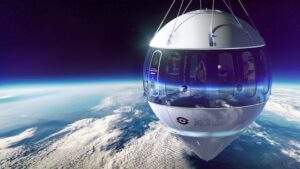Environmental and technological challenges
Hey there, space enthusiasts! Are you ready to unleash your inner alien architect and build the ultimate space colony? Design and architecture play a crucial role in creating functional and sustainable living environments, and this applies even in the vastness of space. In this blog, we’ll explore the exciting world of building space colonies, from futuristic designs to practical considerations. So let’s strap on our virtual hard hats and dive into the enchanting world of space architecture!
Architectural and engineering design
When it comes to building a space colony, are essential factors to consider. The design of the colony must not only be aesthetically pleasing, but it must also be functional and sustainable. The goal is to create a living environment that can support human life and provide all the necessary resources.
Architects and engineers must work together to develop innovative and efficient designs that can withstand the challenges of space. They must consider factors such as gravity, radiation exposure, and limited resources. Additionally, they need to think about how to optimize space utilization and create a sense of community within the colony.
From designing efficient air and water recycling systems to creating self-sustaining ecosystems, the possibilities are endless. So, let’s roll up our sleeves and delve into the intricate details of as we embark on this thrilling journey of building a space colony! Stay tuned for more exciting insights in the upcoming sections.
Sustainability and closed ecosystems
Now, are two crucial aspects that we cannot overlook when it comes to building a space colony. In order to thrive in an extraterrestrial environment, we must create a self-sustaining ecosystem that can recycle and regenerate vital resources like air, water, and food.
One way to achieve this is through the implementation of closed-loop systems. These systems use advanced technologies to recycle and purify water, making it safe for consumption. Air recycling systems play a vital role in maintaining a breathable atmosphere by removing carbon dioxide and replenishing it with oxygen.
Furthermore, agriculture will play a significant role in our sustainable space colony. Traditional farming methods may not be feasible in space, but innovative techniques such as hydroponics and aeroponics can be employed to cultivate crops in limited space using water and nutrient solutions.
By creating a closed ecosystem that mimics Earth’s natural cycles, we can ensure that our space colony remains self-sufficient and capable of supporting human life for generations to come. In our next section, we will explore the fascinating world of sustainable energy solutions for our space colony. Stay tuned!

Psychological and social aspects
Now that we have covered the essential technical aspects of building a space colony, let’s shift our focus to the that are equally important. Living in a space colony will be a completely different experience for humans, and we need to ensure the well-being and mental health of our settlers.
Firstly, the confined and isolated environment of a space colony can lead to feelings of loneliness and isolation. To combat this, we need to create communal spaces where people can interact and socialize. Common areas such as parks, recreation centers, and community gardens can foster a sense of togetherness and provide a break from the confined living quarters.
Secondly, maintaining regular communication with Earth and loved ones will be crucial for the mental well-being of the space settlers. High-speed internet and video conferencing capabilities will help them stay connected and feel a sense of belonging to their home planet.
Lastly, psychological support and counseling services should be readily available for those who may find it challenging to adapt to the unique challenges of space living. Being so far away from Earth, it is essential to provide resources to cope with homesickness, stress, and any other mental health concerns.
By addressing the of space colonization, we can ensure that our settlers have a fulfilling and enriching experience while building a new home in the cosmos. In the next section, we will dive into the fascinating world of sustainable energy solutions for our space colony. Get ready for an electrifying adventure!
Integration with advanced technology
Now that we have discussed the importance of supporting the mental well-being of our space settlers, let’s delve into the exciting realm of integrating advanced technology into our space colony.
As we venture into the vastness of space, it is essential to equip our colony with state-of-the-art technological advancements. One area of focus should be on artificial intelligence and automation. These technologies can help streamline operations and make our space colony more efficient. From managing resources to maintaining life support systems, AI can take on various tasks, freeing up valuable human resources.
Additionally, robotics can play a vital role in the construction and maintenance of our space colony. Whether it’s repairing infrastructure or conducting experiments, robots can handle tasks that would otherwise be challenging or risky for humans.
Moreover, virtual reality (VR) and augmented reality (AR) can enhance the overall experience of living in a space colony. VR can transport settlers to different environments, offering a break from the confines of their living quarters. AR can provide informative overlays, helping settlers navigate the colony and stay connected with the world around them.
By embracing advanced technology, we can create a space colony that is at the forefront of innovation and ensures a smooth and futuristic living experience. In the next section, we will explore the fascinating world of sustainable energy solutions that will power our space colony. Get ready for an electrifying adventure!

Case studies and conceptual proposals
In this next section, we will dive into some intriguing for our space colony. These examples will showcase the possibilities and inspire our own architectural designs.
One compelling case study is the Mars Habitat by Space Exploration Architecture (SEArch+). Their award-winning proposal focuses on using Martian soil to create a radiation-shielded habitat. By utilizing 3D printing technology, they plan to construct a seamless structure that blends with the surrounding environment. This innovative design not only provides protection but also promotes sustainability by utilizing local resources.
Another captivating concept is the Biodome by Extraterrestrial Architecture Lab (XAL). Their vision involves a self-sustaining ecosystem within a transparent dome. This biodome would house various plants and animals, creating a harmonious balance that supports the well-being of our settlers. This type of habitat would not only provide a natural and visually appealing environment, but it would also reduce the need for constant resource replenishment.
These examples demonstrate the potential of combining architectural ingenuity with advanced technology to create a space colony that is both functional and aesthetically pleasing. So, let’s explore these in more detail to fuel our creativity and get our alien architect on!







